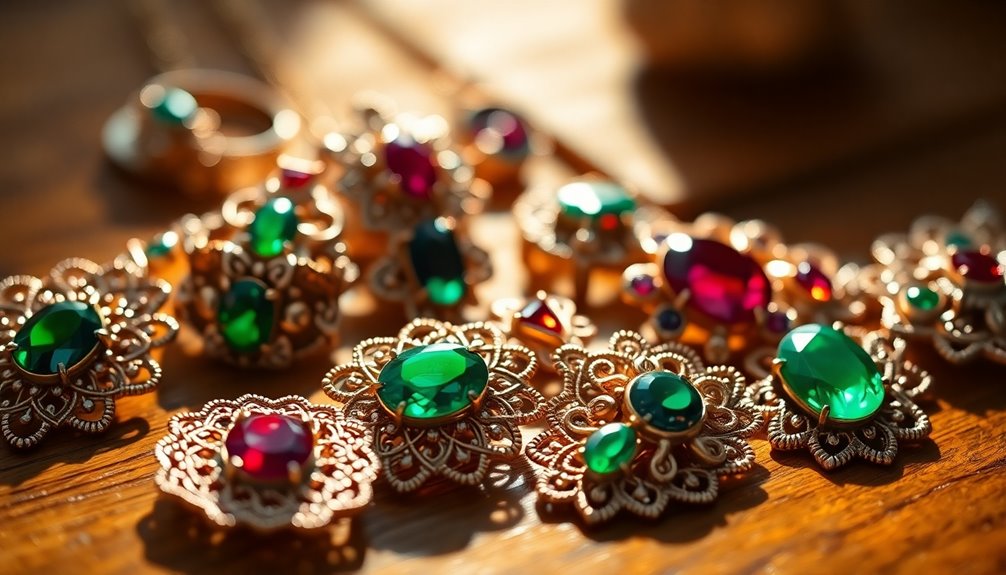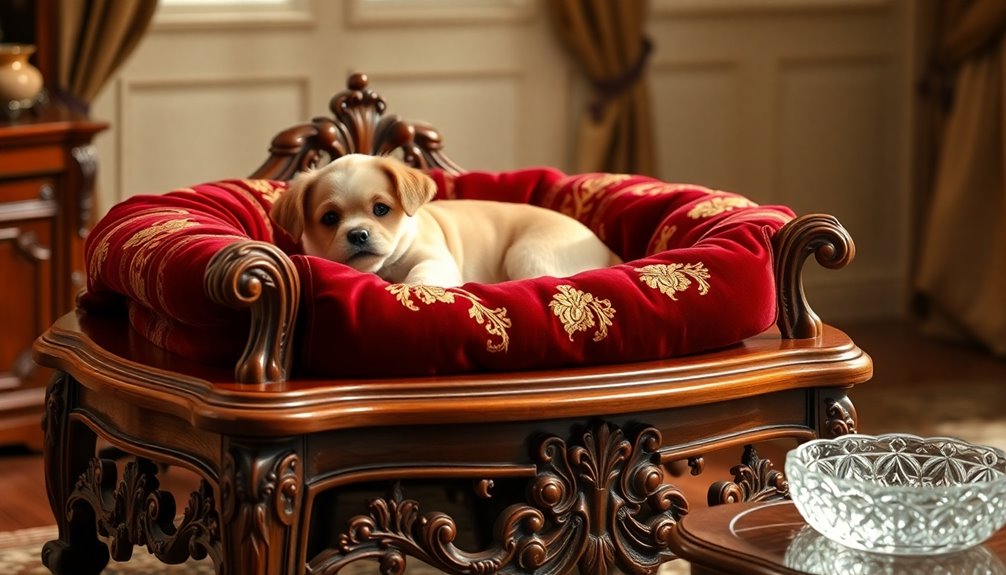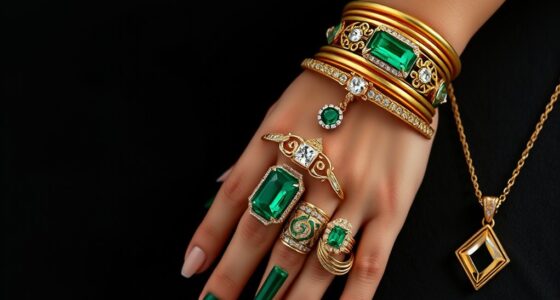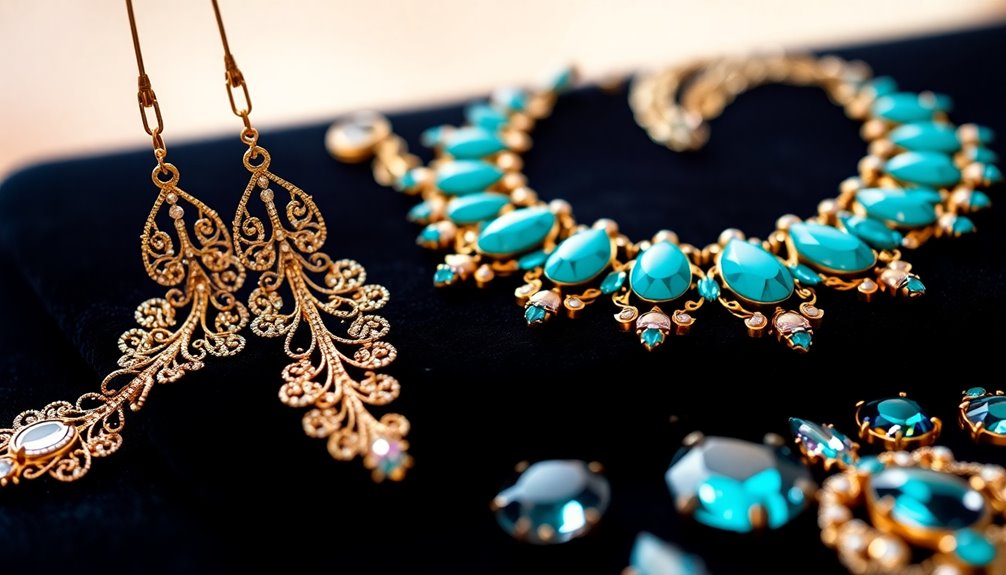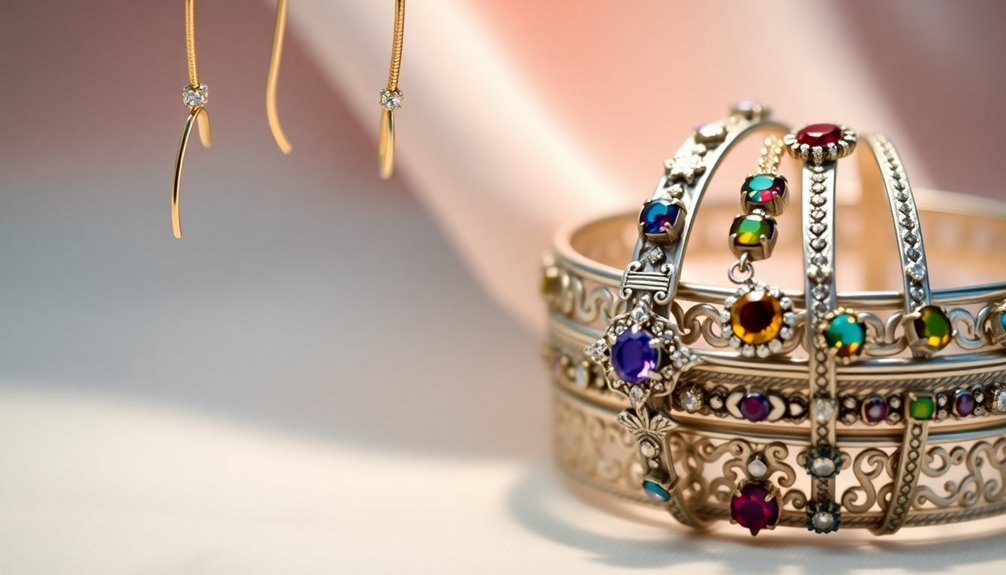Spanish jewelry designers combine vibrant artistry with deep cultural roots, creating pieces that truly stand out. You'll discover talents like Patricia Nicolás, who blends heritage with contemporary flair, and Vicente Gracia, inspired by renowned artists. Their craftsmanship reflects historical influences ranging from Moorish designs to Renaissance gemstones. Using unique materials like 18-karat gold and innovative techniques like filigree work, they produce stunning jewelry that tells a story. Whether you're seeking bold statements or elegant simplicity, these Iberian talents have something for everyone. Keep exploring, and you'll uncover even more about their enchanting creations and the artistry behind them.
Key Takeaways
- Spanish jewelry designers like Patricia Nicolás and Vicente Gracia blend cultural heritage with contemporary aesthetics, showcasing unique artistry in their creations.
- Techniques such as damascene, filigree, and innovative texturing methods highlight the craftsmanship and attention to detail in Spanish jewelry.
- Historical influences, from Moorish designs to Renaissance gemstone markets, enrich the diverse styles seen in modern Spanish jewelry.
- The growing market, projected to exceed $970 million by 2028, reflects rising luxury demand and the impact of digital transformation on sales.
- Sustainability and customization are increasingly prioritized, with brands adopting eco-friendly practices and offering personalized designs to meet consumer desires.
Notable Spanish Jewelry Designers
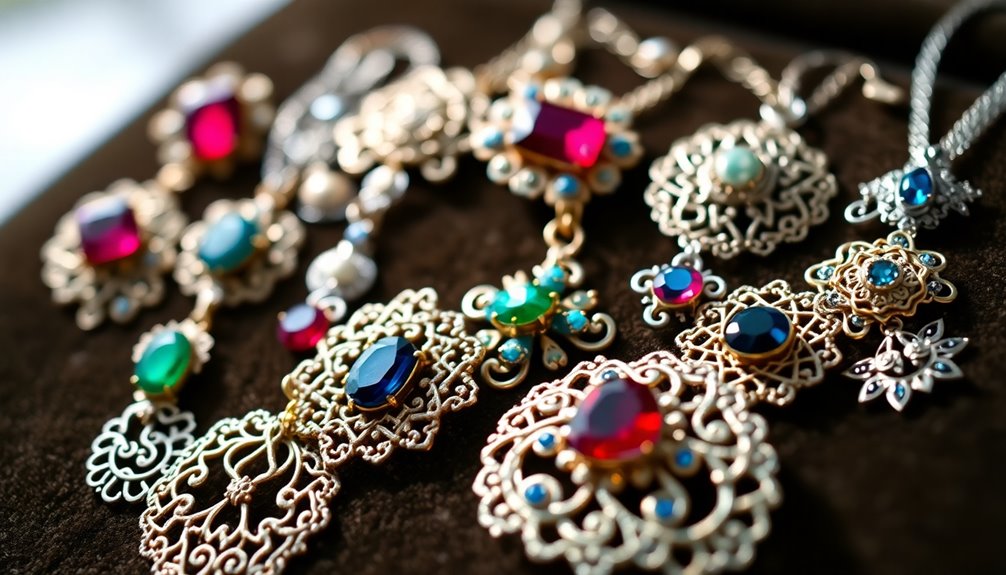
When you think of jewelry, the artistry of notable Spanish designers often comes to mind. Spain boasts a vibrant array of talents, each with unique backgrounds and influences.
Take Patricia Nicolás, for instance; born into a family of jewelers in Madrid, she graduated from Central Saint Martins in London. Her work draws inspiration from cities, Picasso, and the free-spirited nature she embodies.
Vicente Gracia, another luminary, studied under influential artists like Joan Miró and Antoni Tàpies. His designs reflect a fascination with Islamic culture and Arabian Nights, capturing the imagination of many.
Paula Gaviria, a Colombian-born designer, founded Gaviria Jewelry in Barcelona and creates colorful, bold pieces that resonate with contemporary trends. Spain's gold jewelry tradition has greatly influenced her use of vibrant colors and intricate details.
Nuria Blázquez continues a three-generation tradition, showcasing the importance of family heritage in Spanish jewelry design.
Together, these designers represent a rich tapestry of creativity, skill, and cultural inspiration, pushing the boundaries of traditional jewelry making. Each piece tells a story, reflecting the unique vision and artistry of its creator, making Spanish jewelry truly stand out in the global arena.
Unique Materials and Techniques
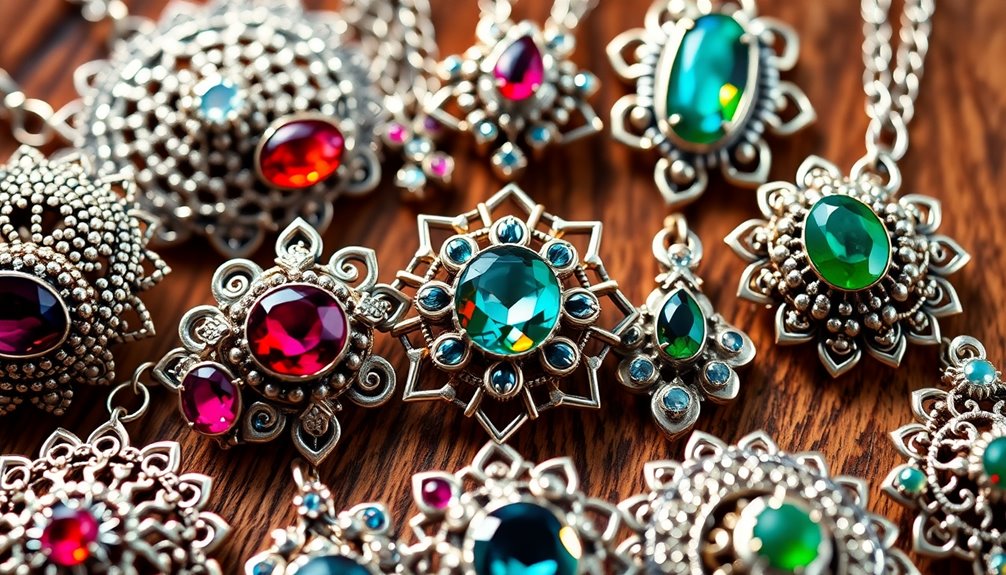
Embracing a rich heritage of craftsmanship, Spanish jewelry designers utilize unique materials and techniques that set their creations apart. You'll often find that their pieces feature 18-karat gold and sterling silver, chosen for their durability and luxury. These precious metals allow skilled artisans to manipulate and craft intricate designs, ensuring each piece is both aesthetically pleasing and long-lasting.
Traditional techniques play a crucial role in Spanish jewelry-making. Many artisans use ancestral methods passed down through generations, such as the damascene technique, which involves inlaying gold or silver onto a base metal like steel or iron. This process includes engraving, hammering, and oxidizing, resulting in stunning, detailed artwork. High recognition for skill in manipulating precious metals is a hallmark of these artisans.
Filigree work is another popular method, showcasing the high-quality craftsmanship that defines Spanish jewelry. Emerging designers are also pushing boundaries, blending traditional practices with modern trends. This innovative spirit leads to unique, exclusive pieces that reflect individual personalities.
With meticulous attention to detail and a focus on quality, Spanish jewelry stands out in the global market, representing not just accessories but true works of art.
Historical Influences on Design

Spanish jewelry design is deeply influenced by its historical context, showcasing a rich tapestry of cultural exchanges. The legacy of Moorish rule left a mark that's hard to miss.
You'll find intricate arabesques and geometric designs that reflect the artistry of the Moors, especially in Toledo, renowned for its Damascene jewelry technique. This method features ornate gold designs on non-precious metals, often showcasing floral and avian motifs against a striking black background.
Christian influences also play a significant role in shaping these designs. You'll encounter Christian symbols like crosses and inscriptions, a testament to the devout Catholicism during the Spanish Inquisition.
This era spurred the creation of numerous relics and crosses, blending spiritual significance with artistic expression. In addition, the introduction of new metals during the 16th century helped artisans develop unique techniques that further enhanced their craft.
Trade and colonial impacts further enriched Spanish jewelry. The Renaissance opened global gemstone markets, allowing jewelers to incorporate vibrant emeralds, rubies, and sapphires into their creations.
Additionally, the Spanish Trail fostered cultural exchange with Native American artisans, leading to unique pieces that blend Spanish and indigenous designs. This fusion continues to resonate in modern jewelry, highlighting the enduring influence of Spain's rich history.
Contemporary Jewelry Styles

Contemporary jewelry styles reflect a vibrant fusion of influences, showcasing the creativity and innovation of modern designers.
You'll notice a striking blend of geometric and organic forms, often inspired by art, music, and literature. Sleek geometric shapes harmonize with delicate designs, while natural motifs like flora and fauna add a touch of romance to the pieces. Many designers offer customizable options, allowing you to create something uniquely yours. For example, brands like Ginger & Velvet provide unique pieces with storytelling and customization.
Materials play a crucial role in these contemporary styles. Designers use diverse materials, including natural and recycled elements like gold brass, resin, and wood, alongside precious metals and semi-precious stones like opals and turquoise.
Innovative techniques, such as plique-à-jour enameling, permit light to dance through translucent enamel, enhancing the visual appeal.
You'll also find quirky, bold designs that transform everyday objects into wearable art. Oversized signet rings and UFO pendants showcase humor and creativity, aimed at strong, sophisticated women.
This eclectic mix of cultural influences and respect for historical contexts results in jewelry that's not just an accessory, but a statement of identity and artistry.
Brand Profiles of Spanish Designers
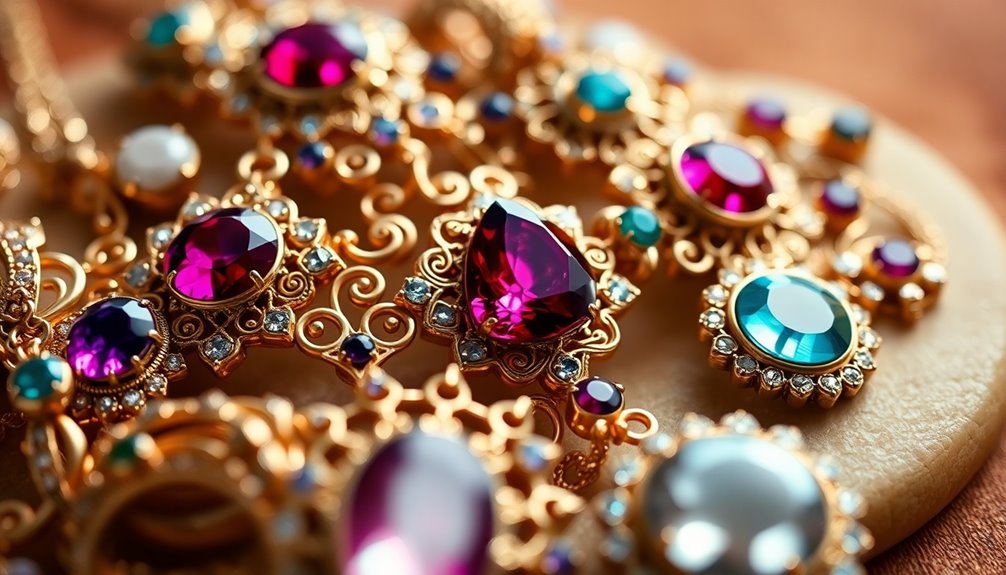
Several outstanding brands are shaping the landscape of jewelry design in Spain, each offering a unique perspective and aesthetic.
Suma Cruz, initially known for bridal headdresses, now delights with nature-inspired jewelry. Patricia Nicolás, hailing from a family of jewelers, combines her heritage with contemporary flair. Beatriz Palacios fuses historical and modern elements, while Sansoeurs, founded by sisters, breaks conventions with their ingenious designs.
Gaviria Jewelry stands out with colorful, chunky pieces that capture contemporary culture, showcasing how jewellery can enhance an outfit's overall appeal. Papiroga embraces bold colors and geometric patterns, often using quirky plexiglass.
Urban Fawn crafts simple yet elegant jewelry inspired by nature and eco-friendly materials. Ginger & Velvet draws inspiration from daily life, art, and literature, offering eclectic forms, while Après Ski showcases vintage aesthetics through handcrafted geometric designs.
Brands like UNO de 50 and Tous emphasize high-quality craftsmanship, blending tradition with modernity. PD PAOLA has gained massive recognition on Instagram for its stylish, affordable pieces.
With over 700 stores worldwide, Tous continues to innovate in jewelry. Each of these brands contributes to a vibrant tapestry of Spanish jewelry that resonates with diverse tastes and preferences.
Craftsmanship and Artisan Workshops
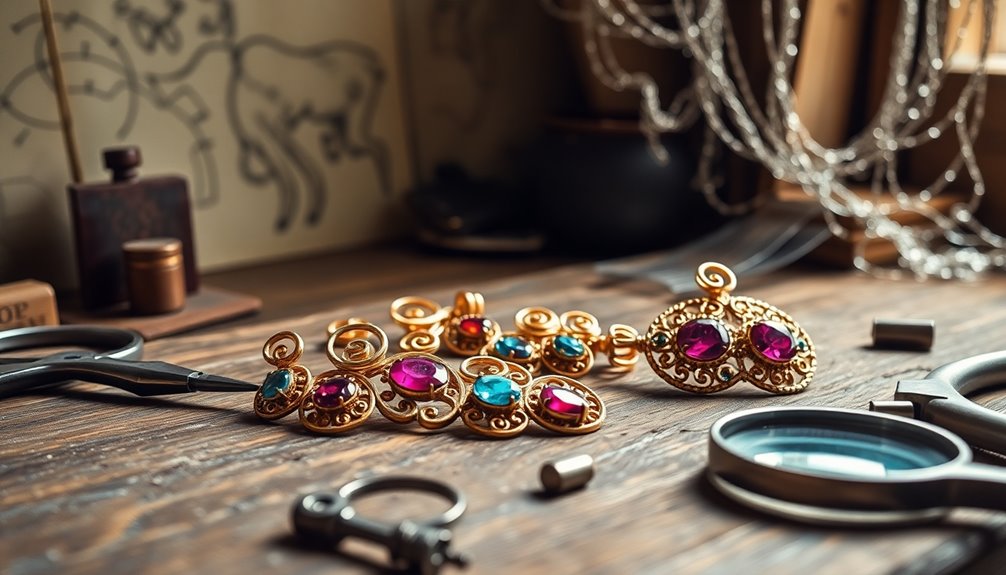
Craftsmanship in jewelry design thrives in Spain, where artisans employ a variety of techniques to create stunning pieces. You'll find methods like soldering, sawing, and polishing, alongside innovative practices such as pressure engraving and fold forming. Textures play a significant role, with artisans using hammering and roller printing to add depth to their creations. Materials range from copper and bronze to silver, natural and synthetic stones, and wood, often finished with touches of 24k gold and sterling silver.
Many workshops invite you to dive into this world, typically held on weekends from 10 a.m. to 2 p.m. You'll learn directly from experienced instructors, like Amparo Valencia, who's over 30 years in handmade jewelry. Poble Espanyol serves as a prime location for experiencing traditional craftsmanship, making it an ideal destination for craft enthusiasts.
Classes cater to small groups, ensuring personalized attention, and are available in Catalan, Spanish, and English. You can expect to create and personalize your own jewelry pieces, experimenting with various techniques. Some workshops even offer visits to local suppliers, giving you insight into the production stages. By participating, you'll not only gain technical knowledge but also unleash your creativity in a supportive environment.
The Future of Spanish Jewelry

The future of Spanish jewelry is looking bright, fueled by a surge in market growth and evolving consumer preferences. The Spanish jewelry market reached $485 million in 2023, showing an impressive 8.8% increase from the previous year. With expectations to add over $970 million by 2028, Spain's growing affluence and rising disposable incomes are driving demand for luxury pieces.
Tourists also contribute significantly, often purchasing jewelry as souvenirs, especially during special occasions that celebrate local culture.
Digital transformation is vital for brands to connect with a broader audience. E-commerce and social media are essential tools for showcasing products and engaging consumers. Innovative strategies like virtual try-ons and online consultations are enhancing the shopping experience.
Sustainability is another key trend. Brands are adopting eco-friendly practices, using ethically sourced materials to align with consumer values, and creating long-lasting pieces that tell a story.
Customization is gaining popularity as consumers seek unique designs that reflect their personal styles. Additionally, collaborations with artists and 3D printing technology are pushing creative boundaries.
Frequently Asked Questions
What Are the Most Popular Gemstones Used in Spanish Jewelry?
When you explore Spanish jewelry, you'll find garnet and topaz stand out as popular choices. Garnet symbolizes loyalty and consistency, while topaz represents love and fidelity.
You might also encounter amethyst, known for promoting peace and tranquility. Rare gemstones like Spanish sphalerite, with its brilliant characteristics, add a unique touch, though it's hard to find.
These gemstones not only enhance the beauty of the pieces but also carry rich historical and cultural significance.
How Can I Identify Authentic Spanish Jewelry Pieces?
To identify authentic Spanish jewelry pieces, check for hallmarks indicating metal purity, like a five-point star or a six-point comet.
Look for maker's marks, typically in a hexagonal shape, and the Assay Office code, which reveals the origin.
Familiarize yourself with the historical designs and motifs, such as the Jerusalem cross or symbols from early kingdoms.
Lastly, ensure the piece complies with modern EU hallmarking regulations to guarantee its authenticity.
Are There Any Jewelry Fairs or Exhibitions in Spain?
Yes, there are several jewelry fairs and exhibitions in Spain.
One of the most prominent is MadridJoya, taking place from February 6-9, 2025, at IFEMA Madrid. This event showcases gold and silver jewelry, precious stones, and more.
You'll also find the Bisutex International Fashion Jewellery and Accessories Trade Fair during the same dates.
These events attract professionals and brands, providing excellent networking and business opportunities in the jewelry sector.
What Is the Price Range for Spanish Designer Jewelry?
When you explore Spanish designer jewelry, you'll find a wide price range.
Emerging designers offer unique, handmade pieces starting from around €42 to €72, making them accessible.
In contrast, traditional and heritage-inspired jewelry can be much pricier, often reflecting craftsmanship and cultural significance.
High-end pieces from established brands can range from several hundred to several thousand euros, depending on materials and brand reputation.
Your choices will vary based on your budget and style preferences.
How Do I Care for and Maintain My Spanish Jewelry?
To care for and maintain your jewelry, check closures and stone settings before wearing to prevent loss.
Handle pieces carefully, avoiding contact with perfumes and cleaning products. Remove your jewelry when showering or swimming.
Clean it regularly using a chamois for simple pieces, and ultrasonic cleaners for stones.
Store each item separately in a cool, dry place, and consider professional inspections and cleaning annually to keep everything looking its best.
Conclusion
In exploring the vibrant world of Spanish jewelry designers, you've discovered a rich tapestry of artistry and innovation. From unique materials to historical influences, each piece tells a story that reflects both tradition and modernity. As you appreciate the craftsmanship and dedication behind these creations, remember that the future of Spanish jewelry is bright, with talented artisans continuing to push boundaries. So, keep an eye on this dynamic scene—there's always something new and exciting to discover!
